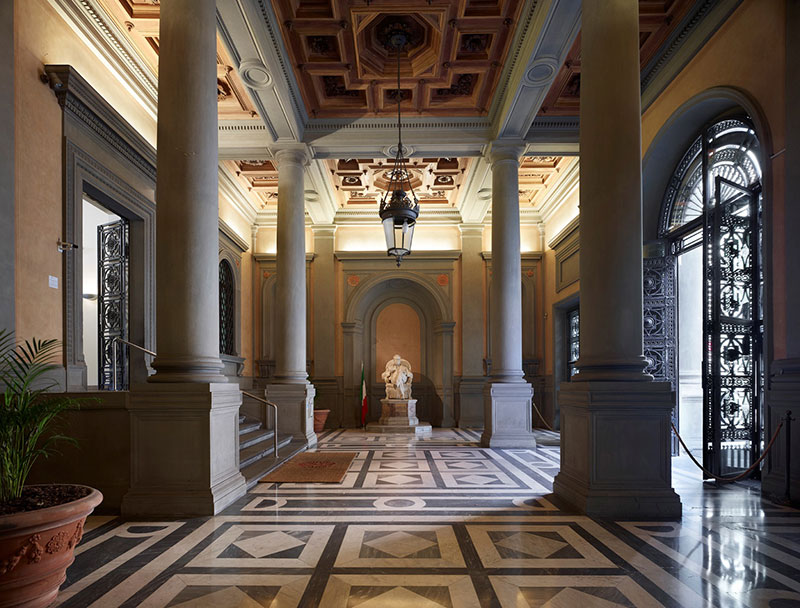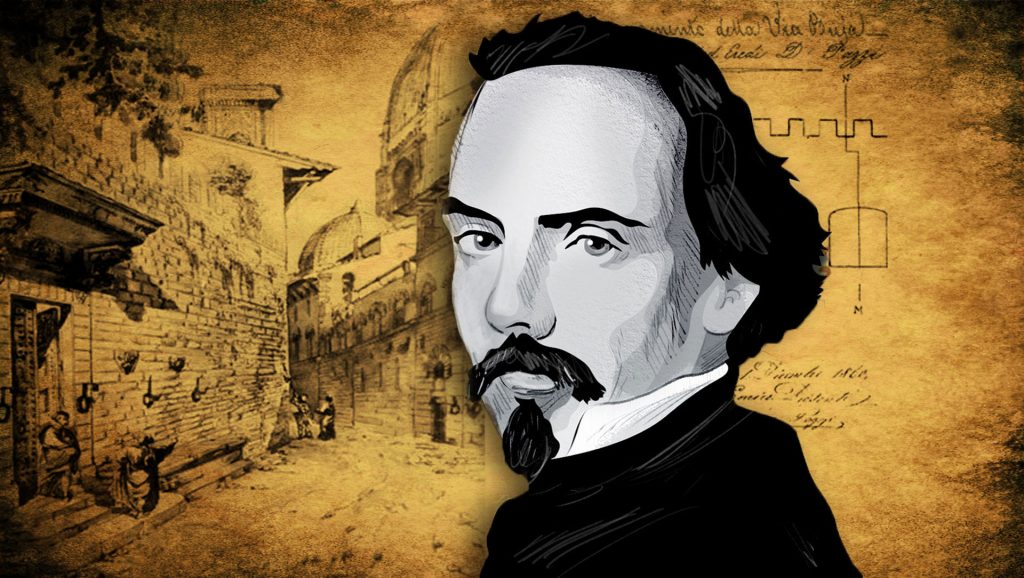Not far from the Duomo in Florence, close to the Oblate library, the imposing Neo Renaissance-style building belonging to the Bank of Italy stands on the other side of via dell’Oriuolo at numbers 37/39. The edifice was constructed between 1865 and 1869 on what had once been the “Orto”, or “Paradiso de’ Pazzi”, the garden belonging to houses owned by Pazzi family members in borgo degli Albizi. An ornate doorway decorated with a shield bearing the Pazzi coat of arms, both designed and sculpted by Donatello, gave entry to the green space. This is now in the San Marco Museum. Neo Renaissance architecture originated in the 19th century and its characteristics include a blending of past styles. The architect would often choose these motifs according to his patrons’ tastes, creating the shell of the edifice, which, like the bank, featured an ample atrium, an impressive staircase and a majestic meeting room, while the artisans, who decorated the interior, used columns, pilasters and other decorative elements evoking the Renaissance.

New headquarters were required for the bank when what was then known as the National Bank of the Kingdom of Italy and, before that, the National Bank of the Sardinian States, was moved from Turin to Florence. This was between 1865 and 1871 when Florence was the capital of the newly unified Italy. The architect Antonio Cipolla was entrusted with the design of the building. Born in Naples on February 4, 1820, Cipolla studied architecture in his hometown and in Rome. His initial important commissions began arriving in the early 1850s. Between 1860 and 1863, he worked on the restoration of Palazzo Farnese in Rome, which was to be the new home of the exiled King Francis II of the Two Sicilies. Between 1862 and 1865, he was awarded a major project in Bologna to erect the National Bank (later the Bank of Italy). In the meantime, in 1864, alongside Florentine architect Vincenzo Micheli, he was called on by Giuseppe Fabbricotti to transform the old Strozzi family hunting lodge into an elegant villa. In 1865, Cipolla also participated in the third round of the competition for the new facade of the Santa Maria del Fiore Cathedral. Throughout this time, he moved in circles close to the Savoy monarchy, even building a bridge across the Arno in 1868 to celebrate the marriage of Prince Umberto, the heir to the Italian throne, and Margherita of Savoy. These commissions would continue with new projects, such as the modernization of the Quirinale stables, and part of the royal residence, when King Vittorio Emanuele II and his court moved to Rome after the city became the Italian capital.
In keeping with the fashion at the time for public buildings, banks and stations, Cipolla’s Florentine Bank of Italy still conveys a sense of solidity, sobriety and simplicity. Over the years, other properties were added in borgo degli Albizi, especially after the building became the Bank of Italy in 1893 following the merger of the National Bank of the Kingdom of Italy, the National Bank of Tuscany, the Credit Bank of Tuscany and the Roman Bank, necessitated by a banking scandal involving the latter, which was liquidated due to the illegal emission of banknotes.

The facade of the bank required extensive and complex restoration, which lasted a year and was completed in 2015. The bank’s building department, with the University of Florence, had the surface plaster removed, thus restoring the frontage to its original intensity and clear nut Siena stone colour tones.
A man who worked tirelessly all his life, mainly in Rome during his final two decades for Italian as well as European and American clients, Antonio Cipolla died in Rome on July 15, 1874 and was buried in his family tomb in the new cemetery in Naples on January 10, 1875.
Since the 1930s, the Bank of Italy has gradually accumulated an important and varied collection of artworks, ranging from ancient oriental art to Italian works of the 20th century, from Roman sculptures to Flemish and French paintings. As these works were intended to adorn meeting rooms and managers’ offices rather than to hang in a museum setting, the collection is distributed throughout the different branches of the bank, including Florence, which occasionally holds themed exhibitions. For more information, see Collezione d’arte Banca d’Italia – Home (bancaditalia.it).








